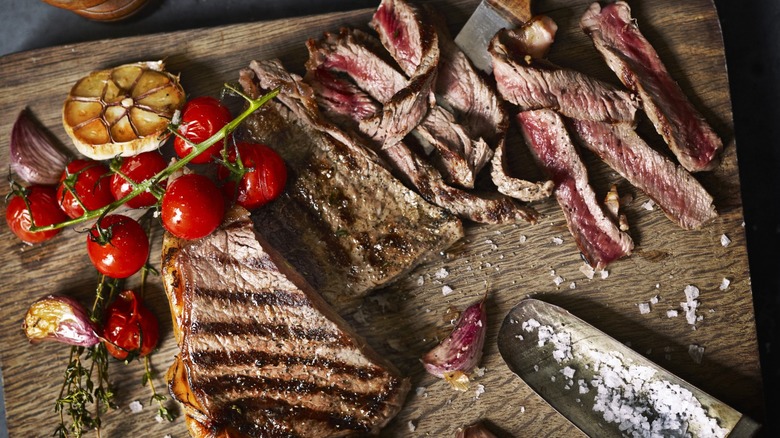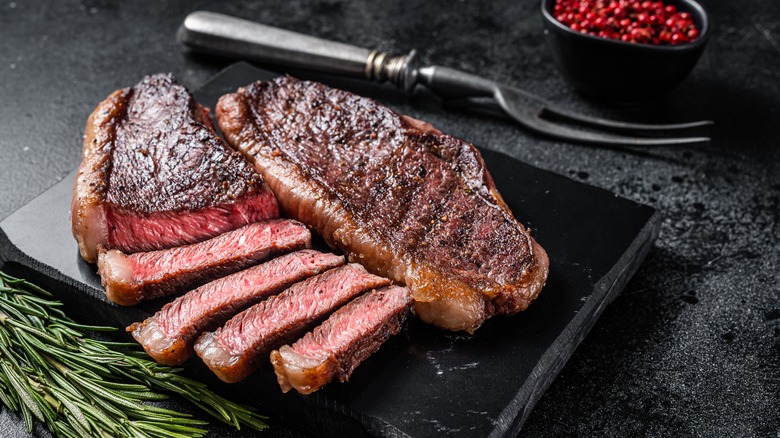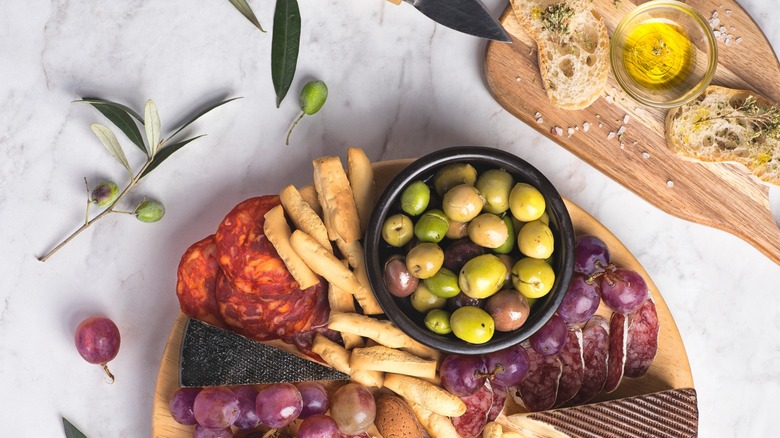Get More Creative With Your Steak By Serving It Charcuterie-Style
It's easy to fall into cooking ruts. Over time, you may find yourself using the same proteins and veggies, the same spice blends, the same hacks for quick sauces. There's no shame in that: The techniques that create the muscle memory required for efficient grocery shopping and quick and easy meal prep can lead to a hint of monotony. So, if you make steaks fairly often, you may be a bit tired of cooking the same vegetable and starch combos served alongside your usual strip or sirloin, and even a little ho-hum about chowing down.
Fortunately, there's a quick fix that transforms any steak dinner into a party. Artfully slicing steak up and serving it charcuterie style–with eye-catching cheeses, fruits, nuts, and other small bites not only refreshes the dish, but is a clever way to introduce different sides, sauces, and garnishes to an everyday meal. If you're already slicing and serving beef on a cutting board you're halfway there. The beauty of this hack is you don't have to change how you prepare and cook your steaks. Season them up, fry or broil them to your tastes: The only thing changing is how they're served.
Preparing steak for a charcuterie board
The French term charcuterie translates from "chair cuit," meaning "cooked flesh." A proper charcuterie board consists of meat, meat, and more meat: generally dried, preserved, and cured. Over the years, the boards we know and love have evolved to feature sliced cheeses, olives, dried fruit, even candy. So there's no harm in slicing up some nice warm steak and presenting it in the same style.
The best cuts of steak for this set-up are thick, boneless cuts like New York strip or top sirloin, or large tender cuts like a ribeye or even a tomahawk. These sear well with a perfectly pink interior, slice easily, and look beautiful spread artfully on the board. Using a sharp knife, cut ¼-inch slices at a slight bias, against the grain (this makes each bite easier to chew). With thinner cuts like flank or skirt, or tougher cuts like chuck filet, marinate them thirty minutes prior to cooking. Even thin-sliced Wagyu on a charcuterie board works wonders.
Prepare other components ahead of time to avoid plating delays: Slice the cheeses and place nuts and grape tomatoes in small ramekins or kobachi bowls (as well as any sauces, gremolata, or chimichurri). Remember the golden rule for filling your charcuterie board is to place the "big" ingredients first. This includes the sliced steak, any solid cheeses, and bread — then you can fill the rest in with your other accompaniments.
The best ingredients for your steak charcuterie board
This is your opportunity to customize the meal in one of two ways. First, by incorporating common charcuterie board fixings (think petite pickles, spiced almonds, fancy cheeses). Or consider deconstructing traditional steak dinner accompaniments into a charcuterie-style presentation. Either method will transform an ordinary meal into an inspiring one.
Remember the board features warm steak rather than cured meats, so design accordingly. Instead of mild goat cheese, consider a sharp cheddar or gorgonzola. Replace crackers with freshly prepared sourdough toast disks or points, and jams with chutneys. Seasoned nuts and dried fruits work nicely, but so do prepared sauces and chopped herbal blends, presented in attractive small dishes guests can use either for dipping or drizzling over the seared steak. Try and avoid boring charcuterie ingredients, like plain radishes or flavorless melon.
Alternatively, think about what normally pairs with steak and craft charcuterie-style presentations. Slice carrots into disks and roast, air fry, or candy. Arrange potatoes, whether mashed, quartered, or scalloped, on attractive small dishes. Decorate the steak with a streak of chimichurri sauce and a large fresh sprig of thyme or oregano. Olives, a charcuterie standard, can be presented whole in a dish or as a tapenade. Grilled asparagus, decoratively draped along the board is a nice touch. Even good old mac-and-cheese can be attractively laid out on a charcuterie board along one side of fanned-out steak slices. The goal here is to get inventive and have fun!


